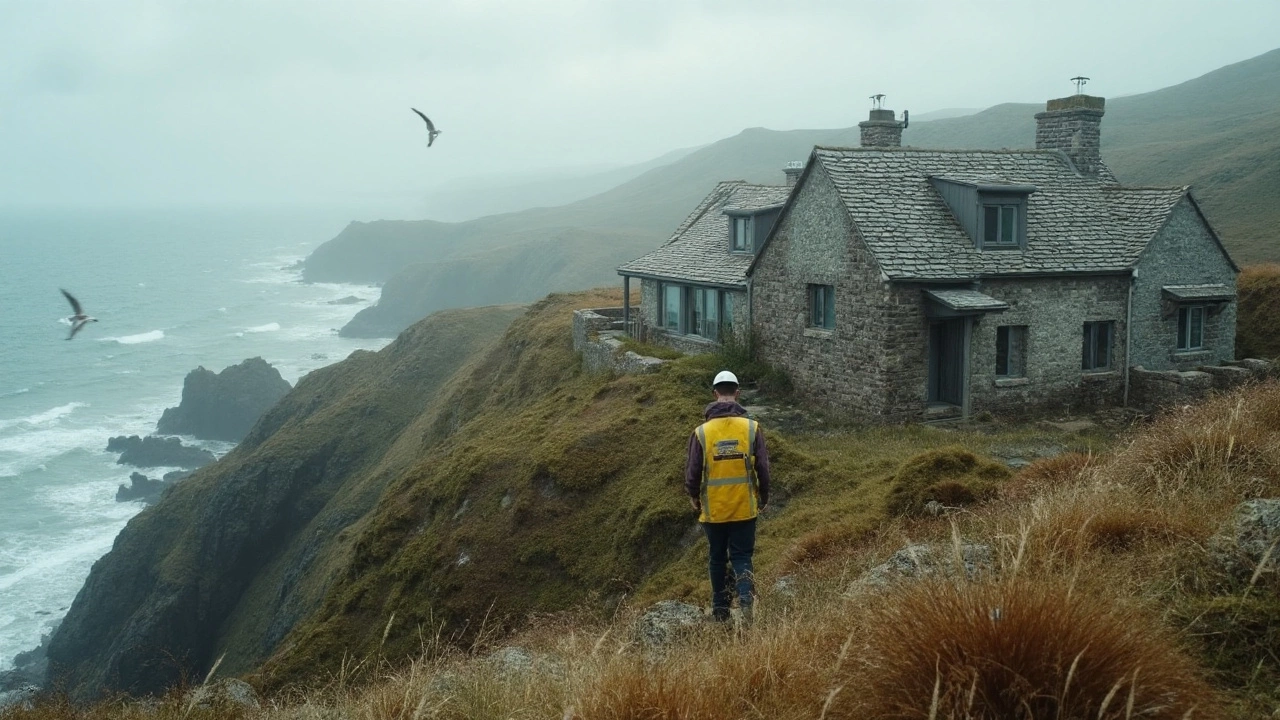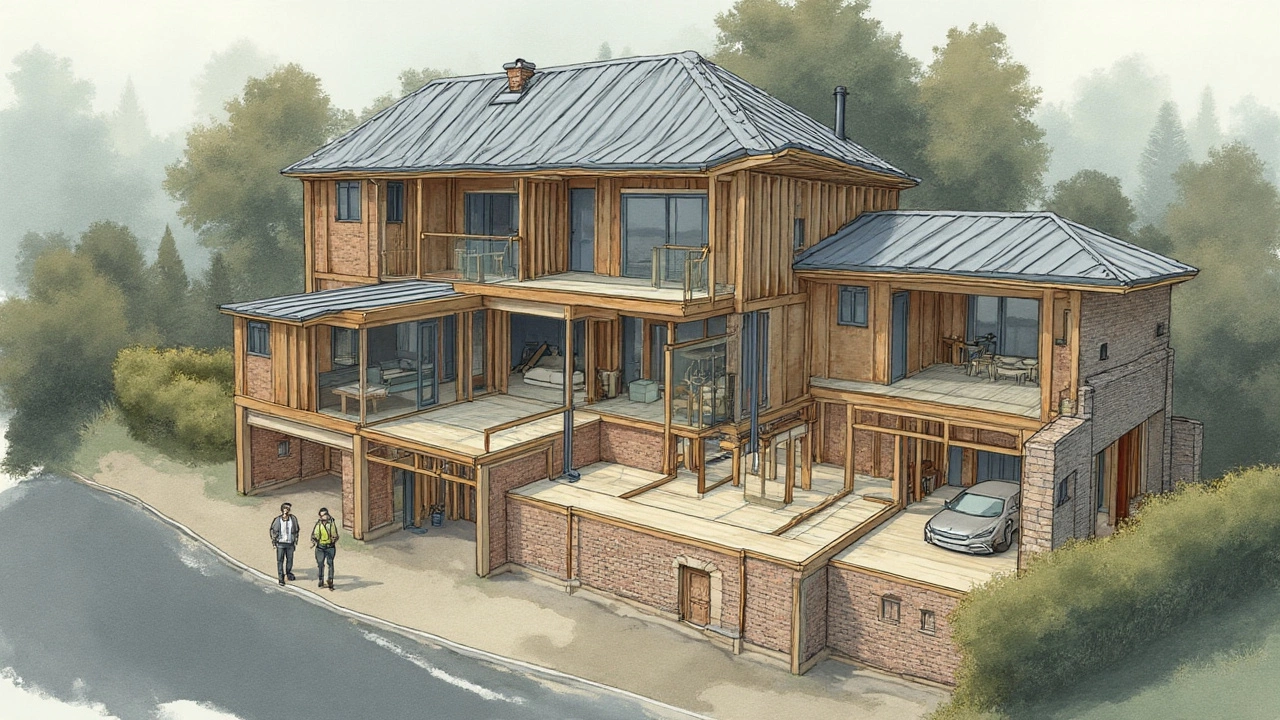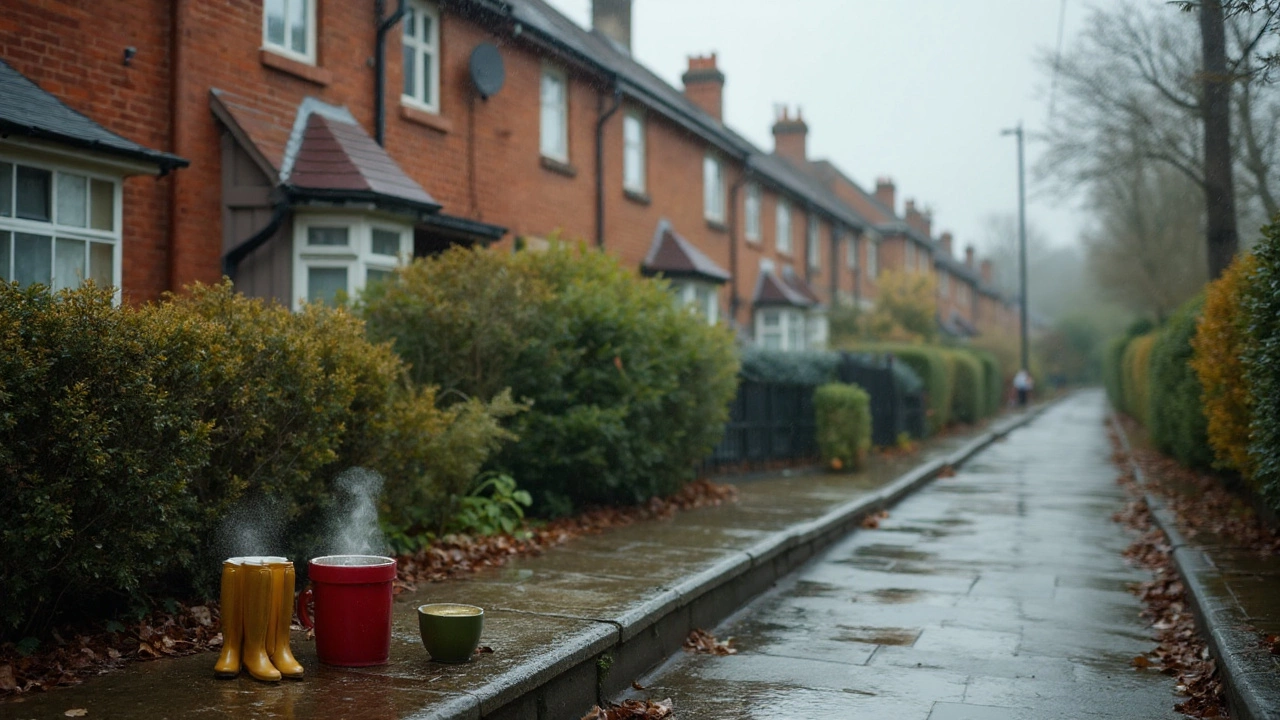What Is the Longest-Lasting Material to Build a House? Lifespan, Trade‑offs, and NZ Conditions
 Sep, 20 2025
Sep, 20 2025
You clicked because you want a straight answer: which house material outlasts the rest? Here’s the short truth-no single material wins in every climate, budget, and design. Stone masonry, fired brick, and high‑quality reinforced concrete can last centuries. But in New Zealand’s earthquakes, salt air, and wild UV, details and maintenance beat bragging rights. If you want a home that outlives you (and maybe your kids), focus on the system-structure, roof, cladding, fixings, moisture control-not just the wall material. I live in windy, shaky Wellington; I build and choose like it.
- TL;DR
- Longest‑lasting structural choices: stone/fired brick masonry (non‑seismic regions), reinforced concrete, and well‑detailed structural steel; mass timber can go the distance if kept dry.
- Longest‑lasting roofs: natural slate, clay tile, copper, and high‑grade zinc. Longrun steel is great value but needs coating cycles.
- What actually decides lifespan: moisture management, seismic detailing, corrosion protection, drainage, and access for maintenance-more than the base material.
- NZ lens (2025): design for earthquakes (NZS 3101, NZS 3604), salt, and UV. NZ Building Code B2 sets 50 years minimum for structure; you can design for 100+ with the right specs.
- Best bet for most Kiwi homes: reinforced concrete or engineered timber structure, ventilated cavity cladding (brick veneer or concrete), and slate or metal roof with correct fixings for your corrosion zone.
What actually lasts the longest? Materials ranked by element (with NZ context)
If you only remember one thing, remember this: the longest‑lasting “material” is a dry one. Moisture is the enemy-of timber, steel, concrete, insulation, and your patience. Now, let’s rank by building element, because that’s how service life is measured in the real world (per ISO 15686 Service Life Planning and NZ Building Code Clause B2 Durability).
Structural frame (lifespan in good design/maintenance):
- Reinforced concrete: 100-150+ years when designed for low permeability, adequate cover, and corrosion protection in marine zones (NZS 3101 exposure classifications). Mis‑spec the cover or let chlorides in, and you’ll invite rebar corrosion.
- Stone or fired brick masonry (solid): centuries in dry, low‑seismic settings; in NZ you’ll need engineered, reinforced masonry to meet earthquake loads. Unreinforced stone/brick is a no‑go for new builds here.
- Structural steel: 100+ years with correct section choice, drainage, and coatings per AS/NZS 2312.1. In C3-C5 coastal zones, hot‑dip galvanizing plus high‑build coatings is the baseline.
- Engineered wood (GLT, LVL, CLT): 75-100+ years if kept dry, detailed with capillary breaks, and protected from UV and standing water. Wet timber fails faster than any steel or concrete mistake.
Roofing (the real longevity champion):
- Natural slate: 100-200+ years with copper/stainless fixings and proper pitch. It’s heavy, so structure must allow for that.
- Clay tile: 80-150 years; frost‑resistant, great in salt air; underlay and battens need periodic attention.
- Copper and zinc standing seam: 80-120+ years, low maintenance; watch runoff compatibility with other metals.
- Longrun steel (Colorsteel, etc.): 30-60 years depending on grade, coating, maintenance, and distance from the sea; reroofing cycles are predictable.
Cladding and envelope:
- Brick veneer: 100+ years; cavity and weep holes must stay clear; ties and fixings should be stainless in coastal zones.
- Rendered masonry/insulated concrete: 75-120+ years if cracks are managed and coatings kept up.
- Fiber‑cement and quality metal cladding: 30-60+ years with repaint cycles and correct fixings.
- Timber weatherboards: 40-80 years if kept painted and ventilated; unmaintained cedar turns from vibe to problem in marine wind.
Windows and doors:
- Thermally broken aluminum: frames 40-70 years; seals and hardware need periodic replacement. Use marine‑grade powder coating near coasts.
- uPVC: 30-50 years; UV‑stable formulations matter with NZ sun. Glazing units often 20-30 years before reseal.
- Timber joinery: 40-70 years with consistent paint and drainage; poor sill design halves this.
Foundations and moisture control:
- Concrete slab with damp‑proof membrane and capillary breaks: 100+ years if drainage and site levels stay right.
- Suspended floors: long life if subfloor ventilation and ground moisture control are dialed in. Poor ventilation kills timber fast.
Below is a quick cheat sheet you can screenshot and take to your designer or builder.
| Element | Material/System | Typical Service Life (yrs) | Relative Cost Index (steel longrun roof = 1.0) | Notes (NZ 2025) |
|---|---|---|---|---|
| Structure | Reinforced concrete | 100-150+ | 1.5-2.5 | Specify cover per NZS 3101, low w/c ratio, marine exposure classes |
| Structure | Reinforced masonry | 100-150+ | 1.5-2.2 | Engineered for seismic; stainless ties near coast |
| Structure | Structural steel | 100+ | 1.5-2.5 | AS/NZS 2312 coatings; avoid trapped water details |
| Structure | Mass timber (CLT/GLT/LVL) | 75-100+ | 1.4-2.2 | Keep dry; vapor control; UV protection at edges |
| Roof | Natural slate | 100-200+ | 3.0-4.0 | Use copper/stainless nails; needs pitch |
| Roof | Clay tile | 80-150 | 2.0-3.0 | Check battens/underlay every 20-30 years |
| Roof | Copper/Zinc | 80-120+ | 2.5-3.5 | Beware galvanic runoff clashes |
| Roof | Steel longrun | 30-60 | 1.0 | Recoat cycles; distance to sea is key |
| Cladding | Brick veneer | 100+ | 1.6-2.5 | Maintain weeps; stainless ties by coast |
| Cladding | Insulated concrete/render | 75-120+ | 1.5-2.5 | Control cracks; breathable finishes |
| Cladding | Metal/fiber-cement | 30-60 | 1.0-1.6 | Correct fixings; repaint intervals |
| Joinery | Thermal aluminum | 40-70 | 1.3-1.8 | Marine powder coat grades; hardware swaps |
| Joinery | uPVC | 30-50 | 1.2-1.6 | Use UV-stable formulations |
Sources for durability expectations: NZ Building Code Clause B2 Durability, ISO 15686, BRANZ durability guidance, NZS 3101 (Concrete), NZS 3604 (Timber), AS/NZS 2312 (Protective coatings on steel).
How to pick the longest‑lasting option for your site (5 steps you can actually use)
Longevity is a decision tree, not a shopping list. Here’s how I walk clients through it-same way I plan my own place so I can spend weekends with Thorne at the beach instead of repainting fascias.
- Start with your site hazards.
- Earthquake zone? In NZ, assume yes. Choose ductile structures: reinforced concrete, engineered timber, or steel. Avoid heavy unreinforced masonry. Detail for drift (sliding joints, movement gaps).
- Coastal corrosion (C3-C5)? Prefer stainless fixings (316 near surf), marine‑grade coatings, extra concrete cover, and avoid mixed metals that set up galvanic corrosion.
- High rainfall or driving wind? Prioritize drained and ventilated cavities behind claddings, generous eaves, and roofing profiles that shed water fast.
- Frost or snow (Central Plateau)? Clay tiles must be frost‑rated; roof pitch matters for slate and tile.
- Lock in a structure you can maintain for 100+ years.
- Reinforced concrete is the safest “century play” if specified right: low water‑cement ratio, adequate cover, and crack control. In marine zones, consider supplementary cementitious materials for durability (e.g., fly ash/slag blends) and attention to joints.
- Engineered timber can match your lifetime if protected from moisture with smart vapor control, overhangs, and capillary breaks. Expose timber only where you can inspect and refinish.
- Steel frames last if you never trap water and you maintain coatings. Design drip edges and inspection access.
- Pick a roof you won’t replace while your kids are still paying off the mortgage.
- Slate or clay tile if you can afford the upfront cost and weight. In earthquake country, secure it properly and design structure for mass.
- High‑grade metal (copper/zinc) if you love low maintenance and clean detailing.
- Longrun steel is the budget workhorse-just plan for recoating/replacement cycles and specify the right grade for your distance from the sea.
- Control moisture like your house’s life depends on it-because it does.
- Ventilated cavities behind claddings, reliable flashings, and breathable yet water‑resistant wraps.
- Slab: damp‑proof membrane, capillary breaks, and site drainage. Suspended floors: generous subfloor ventilation and ground moisture control.
- Inside: powerful extraction in kitchens/baths and continuous background ventilation (ideally balanced ventilation with heat recovery in colder regions).
- Specify the fixings and finishes correctly.
- Stainless where it counts (roof screws, brick ties, coastal fixings). Match metals to avoid galvanic issues.
- High‑build marine coatings where needed and recoat on schedule. Timber elements get proper primer and regular touch‑ups.
- Plan easy access to gutters, flashings, and plant decks-no access equals deferred maintenance equals early failure.
Rule of thumb from practice: spend a little more on the roof and envelope details than on showy finishes. Fancy tapware won’t keep rain out.

Deep dive: by element, what to choose and what to avoid
Structure
- Reinforced concrete: Great for long life if you keep water and chlorides out. Spec 40-65 mm cover depending on exposure, continuous waterproofing at penetrations, and crack control. For coastal Wellington, I prefer higher cementitious content with pozzolans for durability.
- Engineered timber (CLT/LVL): Treat the building like a raincoat. Keep timber out of splash zones, provide end‑grain protection, and avoid wrapping in non‑breathable membranes without a proper hygrothermal plan.
- Steel: Give water a way out; never end a beam inside a warm, humid cavity. Use AS/NZS 2312 system selection for your corrosion category.
Foundations and ground interface
- Slab‑on‑grade: Place a high‑quality DPM under the slab, seal penetrations, and carry the membrane up behind the cladding. Include a capillary break (like a granular layer) and grade the site away from the building.
- Decks: Durability graveyard if done wrong. Isolate deck ledgers from cladding, use stainless fixings, and provide ventilation. Consider freestanding decks to avoid penetrating the weathertight layer.
Roofing
- Slate/clay tile: The elegant “buy once” options. Watch weight and seismic fastening. Copper nails in marine zones; stainless screws on battens.
- Metal roofing: Specify the right substrate (e.g., aluminum near surf beaches), correct fastener grade, and detail for expansion. Keep dissimilar metals apart and control runoff paths.
- Membrane roofs: Not the longest‑lasting, but sometimes you need them. Go for high‑quality membranes, good falls (1:40 minimum where possible), and easy access for inspection.
Cladding
- Brick veneer: A near‑forever skin if the cavity stays clear. Keep weep holes unblocked, and use drips at window heads.
- Insulated concrete (ICF or tilt): Thermally efficient with the longevity of concrete. Watch for control joints and elastic, UV‑stable finishes.
- Timber: If you love the look, protect it. Vertical battens, back‑primed boards, and detailing that lets boards move and breathe.
Windows and doors
- In a coastal environment, choose marine‑grade powder coat on aluminum or timber with robust paint schedules. Always choose stainless hardware. Triple glazing seals last longer if protected from UV and heat.
Interiors that secretly decide longevity
- Bathrooms and laundries: Continuous extraction on humidity sensors; tank your wet areas; specify cement‑based tile backers where possible.
- Ventilation: Balanced systems with heat recovery reduce condensation damage and mould-quietly boosting the life of every material in the house.
Pro tips from the trenches
- Detail every penetration (heat pumps, lights, pipes) before the build. Nothing ages cladding faster than ad‑hoc holes and messy sealant blobs.
- Wide eaves pay you back forever, especially in Wellington’s sideways rain.
- Choose light‑coloured exterior coatings in hot regions; they reduce thermal stress and coating breakdown.
Real‑world picks: scenarios, trade‑offs, and costs (without the spin)
If you want the “longest‑lasting house” for the widest range of NZ conditions, here’s the set‑and‑forget combo I recommend most:
- Structure: reinforced concrete or engineered timber with real moisture management.
- Cladding: brick veneer or insulated/finished concrete with a ventilated cavity.
- Roof: slate (best), clay tile, or high‑grade metal with the right substrate for your corrosion zone.
- Windows: thermally broken aluminum with marine finishes; stainless hardware.
- Fixings: stainless near coast, and no mixed metals.
Common NZ scenarios
- Coastal Wellington (C3-C5): Concrete with marine cover and stainless fixings; brick veneer or concrete cladding; metal roof with aluminum substrate or copper; minimal exposed timber; very careful runoff design.
- High seismic, inland: Engineered timber or RC frame; clay tile or slate roof with seismic fastening; brick veneer fine with flexible ties; avoid brittle interior finishes.
- Rural, low maintenance lifestyle: Concrete or brick veneer, metal roof, big eaves, simple box forms (fewer joints). You’ll spend more upfront but almost nothing on repainting and recladding.
- Eco‑leaning build: Mass timber, metal or brick cladding, and a roof you won’t replace. Low carbon concrete mixes exist; specify SCMs and confirm strength/durability requirements with your engineer.
Cost perspective without the trap
- Slate/clay tile looks pricey on day one, but amortized over 100-150 years, it beats multiple steel roof replacements. Same logic for brick veneer vs. painted timber cladding.
- Hidden costs that kill longevity: poor access for maintenance, cheap fixings, skipping ventilation, mixing metals, and skinny eaves.
- Spend on the envelope before luxury finishes; tiles and tapware date, but cavities and flashings decide lifespan.
Carbon and durability
- Long life reduces whole‑life carbon (ISO 15686 perspective). A 120‑year envelope with minimal replacements often beats a 50‑year system even if the initial footprint is higher.
- Choose durability where replacement is hard: roofs, cladding, and structure. Interiors can be light and lower‑carbon.

Checklists, mini‑FAQ, and next steps
Quick decision checklist
- Hazards mapped (seismic, corrosion, wind): yes/no
- Roof chosen for 80-150 years (not 30): slate/clay/copper/optimized metal
- Cladding with ventilated cavity: yes/no
- Fixings specified by corrosion zone (stainless near coast): yes/no
- Moisture strategy (wraps, flashings, subfloor/slab, ventilation): locked
- Access for maintenance (gutters, roofs, plant): planned
- Movement joints and seismic detailing: on drawings
- Service life targets (ISO 15686) documented: yes/no
Maintenance cheat sheet (what actually keeps things alive)
- Roofs: Inspect annually; clear gutters/valleys; recoat metals per manufacturer’s timeline; replace broken tiles or cracked slate immediately.
- Cladding: Keep cavities clear; check sealants at penetrations every 2-3 years; repaint timber on schedule.
- Concrete/masonry: Seal cracks; keep splash zones dry; check for rust staining near edges-fix early.
- Windows/doors: Replace worn seals; lube hardware; touch up coating chips in marine areas fast.
Mini‑FAQ
- So…what’s the single longest lasting building material? Pure stone or fired brick masonry can last for centuries, and so can well‑designed reinforced concrete. In NZ, because of earthquakes, choose reinforced systems (concrete, masonry) or engineered timber/steel detailed for ductility.
- Is mass timber really long‑lasting? Yes, if it stays dry. Churches and halls in NZ prove timber can last a century or more. The detailing is everything.
- What roof will I never replace? Slate is your lifetime roof. Clay tile and copper/zinc aren’t far behind.
- Does the NZ Building Code guarantee long life? B2 requires 50 years for primary structure and 15 years for most envelope components. You can specify and design for 100+ years; it’s a design/spec decision.
- Are earth or rammed earth houses “forever”? Some last for centuries in dry climates. In NZ, moisture control and seismic reinforcement decide success. Not a casual DIY.
- What kills houses early? Leaks, trapped moisture, corrosion from mixed metals, unmaintained coatings, and poor access for fixing small issues.
Next steps (so you don’t waste months)
- Set a service life target with your designer (e.g., 100 years for structure, 80+ for roof, 60+ for cladding) and tag it to ISO 15686.
- Choose a structural system that fits your hazards: RC or engineered timber for seismic; add corrosion allowances near the coast.
- Pick a roof for at least 80 years. If budget is tight, upgrade from entry‑level steel to a higher‑grade substrate/coating and plan recoats.
- Specify cavities, flashings, and fixings in writing. Use stainless where the sea can breathe on your house.
- Agree on a maintenance plan at handover: roof inspections, recoating intervals, sealant checks. Put it in your calendar. Future you will thank present you.
Troubleshooting by scenario
- Already built near the coast with standard steel roof? Wash down regularly, schedule early recoats, and replace inferior screws with stainless. Add sacrificial gutters if needed.
- Timber cladding greying and cracking? Back to bare where failed, repaint with a system matched to exposure, and improve roof overhangs or add rainscreens if possible.
- Hairline cracks in concrete? Seal them early; check joint detailing; keep chlorides out and you’ll protect the rebar.
Final thought from windy Wellington: your “forever house” is less about one magic material and more about a ruthless focus on dryness, details, and durability specs. Do that, and your home will be standing strong while the fashion changes three times.
